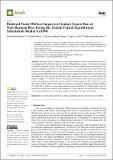| dc.contributor.author | Fathelrahman, Eihab | |
| dc.contributor.author | Osman, Raeda | |
| dc.contributor.author | Hoag, Dana Loyd Keske | |
| dc.contributor.author | Sixt, Gregory N. | |
| dc.contributor.author | Strzepek, Kenneth | |
| dc.date.accessioned | 2024-10-15T19:37:39Z | |
| dc.date.available | 2024-10-15T19:37:39Z | |
| dc.date.issued | 2024-09-30 | |
| dc.identifier.uri | https://hdl.handle.net/1721.1/157316 | |
| dc.description.abstract | India, the world’s leading rice exporter, banned the export of non-Basmati white rice, accounting for 25% of its total exports (or 10% of the global rice trade). The ban aims to ensure availability to domestic Indian consumers and reduce domestic market prices, impacting global rice market accessibility, consumers, and producers across twelve regions. The study utilized the global simulation model (GSIM) to analyze the effects of trade restrictions on industries. The model uses national product differentiation to assess trade policy changes at global, regional, or national scales. It examined importer and exporter effects on trade values, tariff revenues, exporter surplus, and importer surplus. It found that India’s Voluntary Export Restraint (VER) ban on non-Basmati rice resulted in a higher local price and a negative global net welfare impact of USD 1.7 billion. The losses decreased to USD 1.4 billion when importing countries responded by reducing rice import tariffs by 25% and USD 1.1 billion when importing countries reduced tariffs by 75%. Sub-Saharan Africa, the Middle East, North Africa, and the Gulf Cooperation Council regions were most affected. The study also found minimal impact on consumer surplus in India due to inelastic rice demand. | en_US |
| dc.publisher | Multidisciplinary Digital Publishing Institute | en_US |
| dc.relation.isversionof | http://dx.doi.org/10.3390/foods13193124 | en_US |
| dc.rights | Creative Commons Attribution | en_US |
| dc.rights.uri | https://creativecommons.org/licenses/by/4.0/ | en_US |
| dc.source | Multidisciplinary Digital Publishing Institute | en_US |
| dc.title | Bilateral Trade Welfare Impacts of India’s Export Ban of Non-Basmati Rice Using the Global Partial Equilibrium Simulation Model (GSIM) | en_US |
| dc.type | Article | en_US |
| dc.identifier.citation | Fathelrahman, E.; Osman, R.; Hoag, D.L.K.; Sixt, G.N.; Strzepek, K. Bilateral Trade Welfare Impacts of India’s Export Ban of Non-Basmati Rice Using the Global Partial Equilibrium Simulation Model (GSIM). Foods 2024, 13, 3124. | en_US |
| dc.contributor.department | Abdul Latif Jameel Water and Food Systems Lab (Massachusetts Institute of Technology) | en_US |
| dc.relation.journal | foods | en_US |
| dc.identifier.mitlicense | PUBLISHER_CC | |
| dc.eprint.version | Final published version | en_US |
| dc.type.uri | http://purl.org/eprint/type/JournalArticle | en_US |
| eprint.status | http://purl.org/eprint/status/PeerReviewed | en_US |
| dc.date.updated | 2024-10-15T12:53:04Z | |
| dspace.date.submission | 2024-10-15T12:53:04Z | |
| mit.journal.volume | 13 | en_US |
| mit.license | PUBLISHER_CC | |
| mit.metadata.status | Authority Work and Publication Information Needed | en_US |
